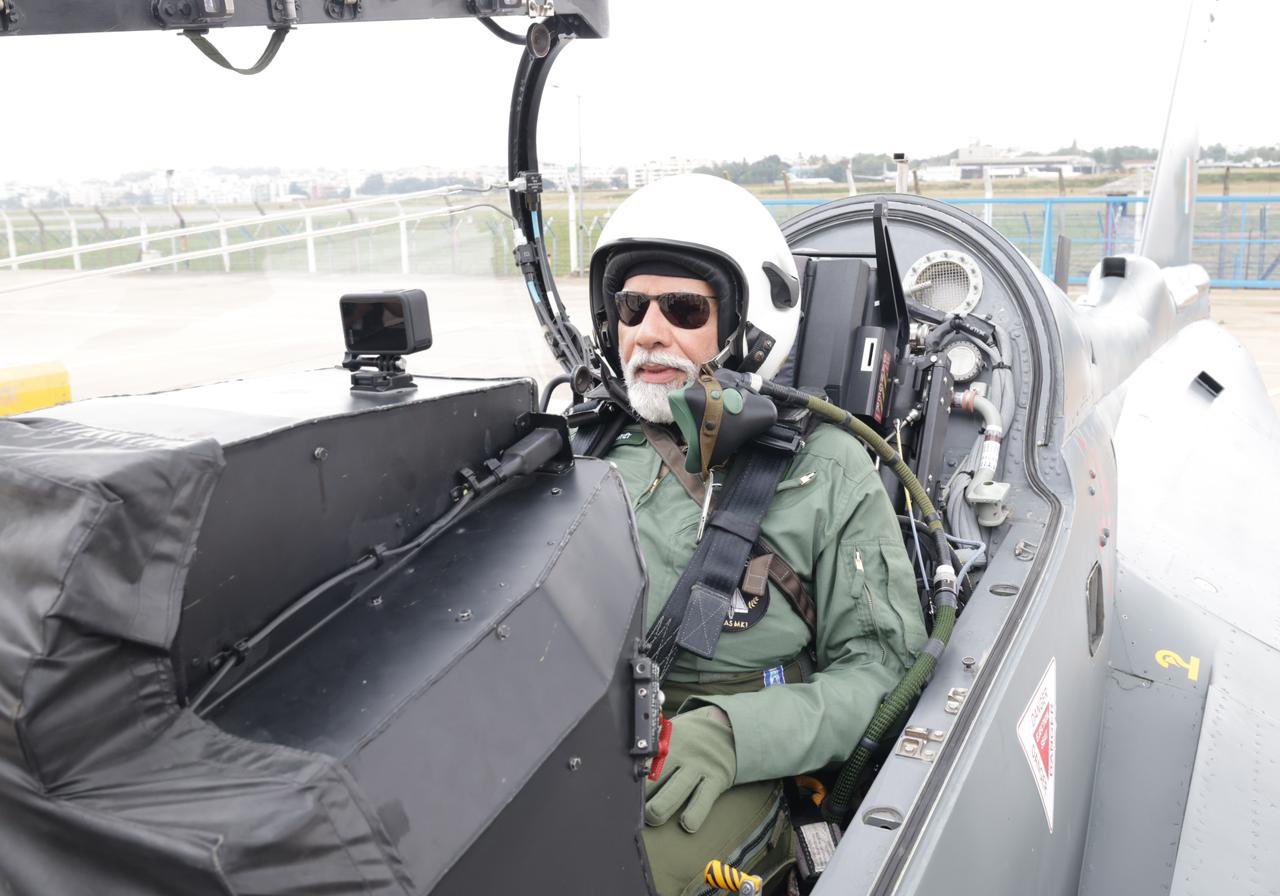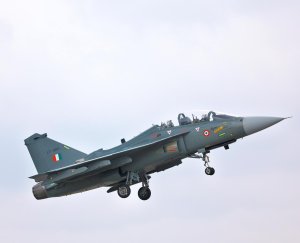Prime Minister Narendra Modi, on November 25, took to the skies on board the indigenously manufactured “Tejas” Light Combat Aircraft to indicate his confidence in the military-industrial prowess of India even as the Air Force seeks to buy 97 more jets for US$7 billion.
“Successfully completed a sortie on the Tejas. The experience was incredibly enriching, significantly bolstering my confidence in our country’s indigenous capabilities, and leaving me with a renewed sense of pride and optimism about our national potential (sic),” Modi posted on social media platform X (formerly Twitter) later that day.
He also hailed the “self-reliance” capabilities of India in defense manufacturing, crediting the Indian Air Force (the user), Defense Research and Development Organization (the developer), and state-run Hindustan Aeronautics Limited (the manufacturer) for the success of the India-made combat jet project. He tweeted this in Hindi.
Modi was in the southern city of Bengaluru, where HAL has its headquarters and manufactures the Tejas. The Indian Prime Minister was there to review the progress of some of the indigenous military aviation platforms when he took the opportunity to fly in a Tejas cockpit, the first by an Indian prime minister.
India has taken nearly 40 years to get a self-made functional combat jet inducted into its air force, with at least two squadrons of the Tejas LCA currently flying operational missions regularly, including close to the northern and western borders with China and Pakistan in recent months.
Successfully completed a sortie on the Tejas. The experience was incredibly enriching, significantly bolstering my confidence in our country's indigenous capabilities, and leaving me with a renewed sense of pride and optimism about our national potential. pic.twitter.com/4aO6Wf9XYO
— Narendra Modi (@narendramodi) November 25, 2023
Air Force Seeks Approval For 97 More Tejas Jets
The Indian Air Force (IAF) has initiated a proposal to purchase 97 more Tejas LCA Mk1A jets from HAL, worth at least US$7 billion. The IAF has sought approval from the Ministry of Defense’s highest decision-making body, the Defense Acquisition Council (DAC), chaired by Defense Minister Rajnath Singh. The DAC will likely take a call on the proposal at its meeting on November 30.
The IAF is already operating two squadrons of the Tejas Mk1 jets, comprising 20 each of Initial and Final Operational Clearance variants. After approval from the Modi-headed Cabinet Committee on Security, the US$6-billion order for 83 LCA Mk1A variants was placed on HAL in February 2021.

The first lot of the LCA Mk1A jets are slated for delivery to IAF in early 2024, following which these would be inducted into functional squadrons as a replacement for the retiring 1960s vintage Soviet-era MiG-21s, the last squadron of which is set to be phased out soon.
The 83-jet order also comprised seven trainer variants of the LCA Mk1A, and thus, this set of Tejas aircraft would be enough to arm at least four fighter squadrons of the IAF. If the follow-on 97-jet order is also approved and the contract signed with HAL, these additional Tejas aircraft would be enough for another five fighter squadrons. Thus, Tejas would become a significant part of IAF’s fighter strength in the years to come, with at least ten squadrons of the 42 sanctioned fighter squadrons operating the locally-made combat jets.
मैं आज तेजस में उड़ान भरते हुए अत्यंत गर्व के साथ कह सकता हूं कि हमारी मेहनत और लगन के कारण हम आत्मनिर्भरता के क्षेत्र में विश्व में किसी से कम नहीं हैं। भारतीय वायुसेना, DRDO और HAL के साथ ही समस्त भारतवासियों को हार्दिक शुभकामनाएं। pic.twitter.com/xWJc2QVlWV
— Narendra Modi (@narendramodi) November 25, 2023
India’s Bid To Export Tejas Hasn’t Had Success
The induction of the LCA into the IAF was a likely boost for India’s bid to emerge as a major exporter of arms globally. India has recently tried to sell the Tejas to friendly foreign nations and has showcased the jet at international air shows to impress prospective customers. Earlier this month, Tejas competed for attention against Chinese J-10C and Pakistan’s JF-17 Thunder Block-3 fighter aircraft at the Dubai Air Show.

India’s first serious attempt to export Tejas jets was when it offered it to the Malaysian Air Force to meet its need for 18 light combat jets. Though downselected as a final contender, Tejas lost out to South Korea’s FA-50 jets there. India tried to sweeten the offer, ensuring a Maintenance, Repair, and Overhaul (MRO) facility, providing aviation management training and collaborating with Malaysian firms to manufacture the aerostructures locally in Malaysia.
Other nations have shown interest in Tejas jets, too. Argentina, seeking to buy fighters, had shown interest in Tejas with its Defense Minister Jorge Taiana visiting the HAL facility and taking a closer look at the Indian combat jet. However, the latest reports from Argentina show that the South American nation would go with the American offer of F-16s against the Chinese offer of JF-17s or the Indian Tejas.
HAL had also recently sent its engineers to the Philippines to convince Manila to go for the Tejas aircraft to purchase 12 multi-role fighter jets. In the Philippines, too, India’s Tejas would compete against South Korean FA-50, which won the Malaysia contest previously.
Nigeria, too, expressed its interest in the LCA as part of a US$1-billion deal it seeks with India to enable the development of the former’s military-industrial complex. But the details of Nigerian interest in LCA — whether to buy it for its armed forces or seek industrial cooperation with Hindustan Aeronautics Limited — are unclear.
Despite these forays into the export market, HAL faces a massive hurdle in its capacity to quickly build the required jets to meet the Indian Air Force’s needs and export market commitments. As this EurAsian Times analysis revealed, HAL can build only 16 jets annually in two production lines while it is pursuing the setting up of a third production line to enhance its capacity to 24 jets a year.
With its commitment to manufacturing 83 jets already and another 97 jets order in the offing, it could turn out to be a Herculean task for HAL to meet both its domestic and foreign delivery commitments for the Tejas aircraft, provided it scores big and successfully bags an export order soon.
- NC Bipindra is a 30-year veteran in journalism specializing in strategic affairs, geopolitics, aerospace, defense, and diplomacy. He has written extensively for the Times of India, New Indian Express, Press Trust of India, and Bloomberg News. He can be reached at ncbipindra (at) gmail.com
- Follow EurAsian Times on Google News




